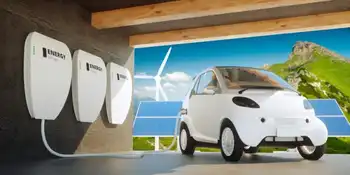Winds of Change: Vineyard Wind Ushers in a New Era for Clean Energy

Protective Relay Training - Basic
Our customized live online or in‑person group training can be delivered to your staff at your location.

- Live Online
- 12 hours Instructor-led
- Group Training Available
Vineyard Wind Offshore Wind Farm delivers clean power to Massachusetts near Martha's Vineyard, with 62 turbines and 800 MW capacity, advancing renewable energy, cutting carbon, lowering costs, and driving net-zero emissions and green jobs.
Key Points
An 800 MW Massachusetts offshore project of 62 turbines supplying clean power to 400,000+ homes and cutting emissions.
✅ 800 MW powering 400,000+ MA homes and businesses
✅ 62 turbines, 13 MW each, 15 miles from Martha's Vineyard
✅ Cuts 1.6M tons CO2 annually; boosts jobs and port infrastructure
The crisp Atlantic air off the coast of Martha's Vineyard carried a new melody on February 2nd, 2024. Five colossal turbines, each taller than the Statue of Liberty, began their graceful rotations, marking the historic moment power began flowing from Vineyard Wind, the first large-scale offshore wind farm in the United States, enabled by Interior Department approval earlier in the project timeline. This momentous occasion signifies a seismic shift in Massachusetts' energy landscape, one that promises cleaner air, lower energy costs, and a more sustainable future for generations to come.
Nestled 15 miles southeast of Martha's Vineyard and Nantucket, Vineyard Wind is a colossal undertaking. The project, a joint venture between Avangrid Renewables and Copenhagen Infrastructure Partners, will ultimately encompass 62 turbines, each capable of generating a staggering 13 megawatts. Upon full completion later this year, Vineyard Wind will power over 400,000 homes and businesses across Massachusetts, contributing a remarkable 800 megawatts to the state's energy grid.
But the impact of Vineyard Wind extends far beyond mere numbers. This trailblazing project holds immense environmental significance. By harnessing the clean and inexhaustible power of the wind, Vineyard Wind is projected to annually reduce carbon emissions by a staggering 1.6 million metric tons – equivalent to taking 325,000 cars off the road. This translates to cleaner air, improved public health, and a crucial step towards mitigating the climate crisis.
Governor Maura Healey hailed the project as a "turning point" in Massachusetts' clean energy journey. "Across the Commonwealth, homes and businesses will now be powered by clean, affordable energy, contributing to cleaner air, lower energy costs, and pushing us closer to achieving net-zero emissions," she declared.
Vineyard Wind's impact isn't limited to the environment; it's also creating a wave of economic opportunity. Since its inception in 2017, the project has generated nearly 2,000 jobs, with close to 1,000 positions filled by union workers thanks to a dedicated Project Labor Agreement. Construction has also breathed new life into the New Bedford Marine Commerce Terminal, with South Coast construction activity accelerating around the port, transforming it into the nation's first port facility specifically designed for offshore wind, showcasing the project's commitment to local infrastructure development.
"Every milestone on Vineyard Wind 1 is special, but powering up these first turbines stands apart," emphasized Pedro Azagra, CEO of Avangrid Renewables. "This accomplishment reflects the years of dedication and collaboration that have defined this pioneering project. Each blade rotation and megawatt flowing to Massachusetts homes is a testament to the collective effort that brought offshore wind power to the United States."
Vineyard Wind isn't just a project; it's a catalyst for change. It perfectly aligns with Massachusetts' ambitious clean energy goals, which include achieving net-zero emissions by 2050 and procuring 3,200 megawatts of offshore wind by 2028, while BOEM lease requests in the Northeast continue to expand the development pipeline across the region. As Energy and Environmental Affairs Secretary Rebecca Tepper stated, "Standing up a new industry is no easy feat, but we're committed to forging ahead and growing this sector to lower energy costs, create good jobs, and build a cleaner, healthier Commonwealth."
The launch of Vineyard Wind transcends Massachusetts, serving as a beacon for the entire U.S. offshore wind industry, as New York's biggest offshore wind farm moves forward to amplify regional momentum. This demonstration of large-scale development paves the way for further investment and growth in this critical clean energy source. However, the journey isn't without its challenges, and questions persist about reaching 1 GW on the grid nationwide as stakeholders navigate timelines. Concerns regarding potential impacts on marine life and visual aesthetics remain, requiring careful consideration and ongoing community engagement.
Despite these challenges, Vineyard Wind stands as a powerful symbol of hope and progress. It represents a significant step towards a cleaner, more sustainable future, powered by renewable energy sources at a time when U.S. offshore wind is about to soar according to industry outlooks. It's a testament to the collaborative effort of policymakers, businesses, and communities working together to tackle the climate crisis. As the turbines continue their majestic rotations, they carry a message of hope, reminding us that a brighter, more sustainable future is within reach, powered by the wind of change.
Additional Considerations:
- The project boasts a dedicated Fisheries Innovation Fund, fostering collaboration between the fishing and offshore wind industries to ensure sustainable coexistence.
- Vineyard Wind has invested in education and training programs, preparing local residents for careers in the burgeoning wind energy sector.
- The project's success opens doors for further offshore wind development in the U.S., such as Long Island proposals gaining attention, paving the way for a clean energy revolution.











